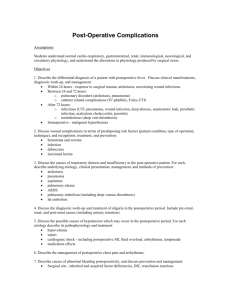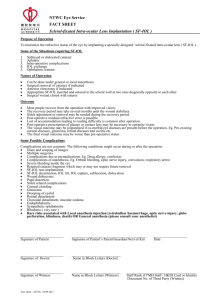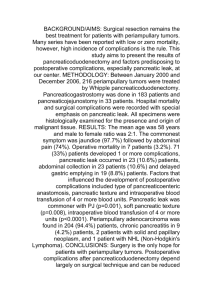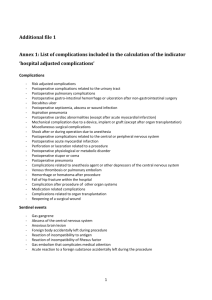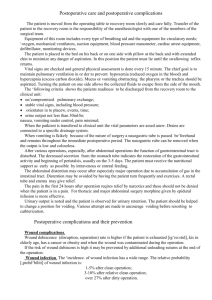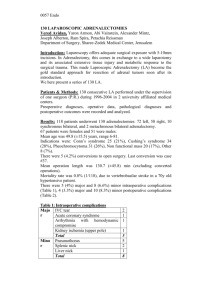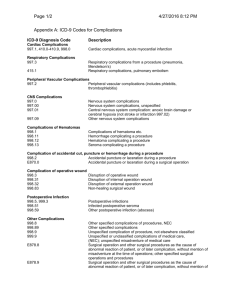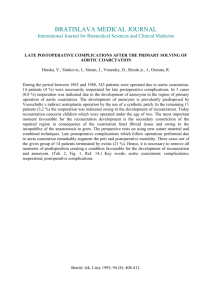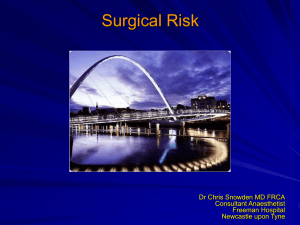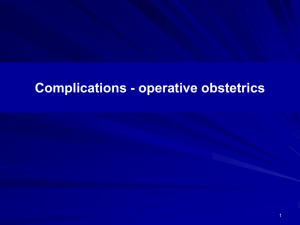Surgical Complications
advertisement
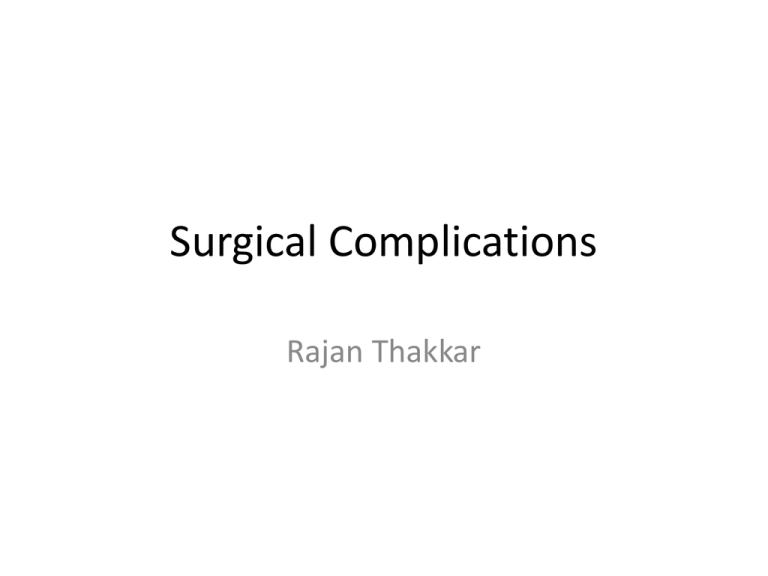
Surgical Complications Rajan Thakkar Surgical Complications • • • • • • • • • Wound Thermal Regulation Postoperative Fever Pulmonary Cardiac Renal Gastrointestinal Metabolic Neurological Surgical Complications • • • • • Primary disease Operation Unrelated factors Complications leading to other complications Prevention Wound Complications • • • • • Dehiscence Seroma Hematoma Infection Incisional Hernia Wound Dehiscence • • • • • • Separation of facial layers Serosanguinous drainage Technical Complication Risk Factors Mortality approaches 30% Evisceration Evisceration Incisional Hernia Seroma • Collection of liquefied fat, serum and lymphatic fluid under the incision • Benign • No erythema or tenderness • Mastectomy, axillary and groin dissections • Treatment Hematoma • Abnormal collection of blood – Discoloration of the wound edges (purple/blue) – Blood leaks through skin sutures • Imperfect hemostasis • Potential for secondary infection • Neck hematomas can be dangerous Wound Infection • • • • • • • • Major problem Superficial Deep Organ space Most commonly occur 4-6 days post-op Erythema, tender, edema 2.5% of abdominal incisions Staphylococcus aureus Wound Infection • Necrotizing fasciitis – Bacterial infection of underlying fascia – Classically Streptococcus, most often polymicrobial with anaerobes/GNR – Surgical debridement and IV antibiotics • Clostridial Myosistis – Clostridial muscle infection (myonecrosis and gas gangrene) – Clostridium perfringens – Surgical debridement and IV antibiotics Necrotizing fasciitis Necrotizing fasciitis Necrotizing Fasciitis Complications of Thermal Regulation • Hypothermia • Malignant Hyperthermia Hypothermia • • • • Drop in body temperature of 2 degrees C Causes Body’s Response Temperature below 35 C – Coagulopathic – Platelet dysfunction • • • • Mild - 32 – 35C = 90-95F Mod – 28 – 32C = 82–90F Severe – 25 – 28C = 77-82F Extreme Malignant Hyperthermia • • • • • Rare; autosomal dominant Fever, tachycardia, rigidity, cyanosis First sign is increased end tidal CO2 Often within 30 minutes Treatment: Dantrolene, correct electrolytes, cooling blanket Postoperative Fever • The Six W’s – – – – – – • Wind: pneumonia Wound: infections Water: UTI Walking: DVT (possible PE) Waste: abscess Wonder Drug: medication Noninfectious – Within the first 48-72 hours • Infectious – Fevers POD 3-8 – Standard work up includes • • • • • Blood cultures UA and Urine Cultures CXR Sputum cultures Tylenol/Motrin Pulmonary Complications • Atelectasis – Peripheral alveolar collapse due to shallow tidal breaths – Most common cause of fever within 48 hours of surgery – Incentive spirometry • Aspiration Pneumonitis – Reduced by pre-op fasting, protonix, cricoid pressure • Nosocomial Pneumonia • Pulmonary edema – CHF – ARDS • Pulmonary embolus – 500,000 per year – 1 in 5 are fatal – Prevention Pulmonary Embolus ARDS Cardiac complications • Hypertension • Ischemia/Infarction – Leading cause of death in any surgical patient – Key to treatment: prevention – MONA • Arrhythmias – >30 seconds of abnormal cardiac activity – Key to treatment is to correct underlying medical condition Renal Complications • Urinary retention – Inability to evacuate a urine-filled bladder – Commonly a reversible abnormality – Perianal and Hernia repairs • Acute Renal Failure – Pre-renal – Intrinsic – Post-renal Gastrointestinal Complications • • • • • • Postoperative ileus GI Bleeding Pseudomembranous colitis Ischemic Colitis Anastomotic Leak Enterocutaneous fistula Postoperative Ileus • Lack of function without definitive obstruction • Prolonged by extensive operative manipulation, SB injury, narcotic use, abscess and pancreatitis • Must be distinguished from SBO • Flat and Upright abdominal film – Ileus: dilated bowel throughout, air in colon and rectum – SBO: air fluid levels, no colonic or rectal air ILEUS SBO Gastrointestinal Complications • GI Bleeding – From Any source (get a detailed history) – Gastric “stress” ulcers (Curling’s Ulcer) • Uncommon with invention of H2Blockers and PPIs • Pseudomembranous colitis – Superinfection with C difficile – Alteration of intestinal flora by perioperative antibiotics – Toxic colitis is a surgical emergency (mortality of 20-30%) • Ischemic Colitis – Bowel affected helps determine cause – Surgical devascularization, hypercoagulable states, hypovolemia and emboli • Anastomotic leak • Enterocutaneous fistula – The most complex and challenging surgical complication C diff colitis C diff colitis Anastomotic leak in GBP Metabolic Complications • Adrenal Insufficiency – Uncommon but potentially lethal – Sudden cardiovascular collapse • Hypotension, fever, confusion, abdominal pain – “Stim” test, administration of hydrocortisone • Baseline serum cortisol, 30 min, 60 min • Hyper/Hypothyroidism • SIADH – Continued ADH secretion despite hyponatremia – Neurosurgical procedures, trauma stroke, drugs (ACEI, NSAIDs) Neurologic Complications • • • • Beware the drugs you will be prescribing Delirium, Dementia and Psychosis Seizure Disorders Stroke and Transient Ischemic Attacks
